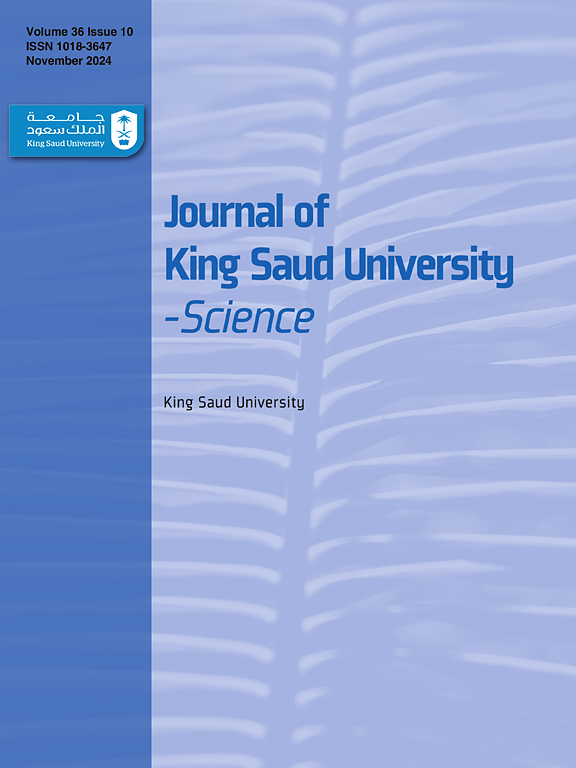Genomic insights into the diversity of mango cultivars in Saudi Arabia: Fluorescent SSR marker analysis
IF 3.7
3区 综合性期刊
Q1 MULTIDISCIPLINARY SCIENCES
引用次数: 0
Abstract
Objectives
This study presents a comprehensive genetic analysis of twelve mango cultivars from Saudi Arabia, investigating their genetic diversity, population structure, and potential loci under selection.
Methods
Utilizing ten SSR loci, we conducted a thorough assessment of allele variation, revealing diverse patterns across loci and defined genetic diversity among cultivars.
Results
Notably, certain loci exhibited extensive allele diversity, with Loci M02 and M06 displaying five and seven alleles, respectively, while others showed more limited profiles, such as Locus M01 with only two alleles. Surprisingly, clustering patterns based on genetic relatedness did not consistently align with anticipated geographic groupings, suggesting additional factors influencing genetic structure beyond geography. Further analysis of allele sharing provided insights into the genetic relatedness among cultivars, highlighting both close genetic affinities and significant divergence. Subsequent Allele Sharing Matrix analysis unveiled sub-clustering within clusters, revealing finer-scale genetic structures within the population. Assessment of genetic differentiation using Analysis of Molecular Variance demonstrated significant variations among clusters and individuals, with variations among clusters ranging from 3% to 53%. Additionally, testing for loci under selection identified potential markers, such as locus M11, with observed heterozygosity greater than expected (1.024) and a relatively low observed FST value of 0.2695.
Conclusions
Overall, our findings contribute to the characterization of mango genetic resources in Saudi Arabia, providing crucial information for breeding programs, germplasm conservation efforts, and agricultural practices. By leveraging advanced genomic technologies and interdisciplinary collaborations, future research can delve deeper into the genetic basis of adaptive traits and agronomic characteristics, paving the way for innovative strategies to enhance mango production and sustainability in Saudi Arabia.
沙特阿拉伯芒果栽培品种多样性的基因组学启示:荧光 SSR 标记分析
方法利用 10 个 SSR 位点,我们对等位基因变异进行了全面评估,揭示了各位点间的不同模式,并确定了栽培品种间的遗传多样性。结果值得注意的是,某些位点显示出广泛的等位基因多样性,位点 M02 和 M06 分别显示出 5 个和 7 个等位基因,而其他位点则显示出较为有限的特征,如位点 M01 只有两个等位基因。令人惊讶的是,基于遗传亲缘关系的聚类模式与预期的地理分组并不一致,这表明除地理因素外,还有其他因素影响着遗传结构。对等位基因共享的进一步分析深入揭示了栽培品种之间的遗传亲缘关系,既突出了密切的遗传亲缘关系,也显示了显著的差异。随后的等位基因共享矩阵分析揭示了聚类内部的亚聚类,揭示了种群内部更精细的遗传结构。分子变异分析对遗传分化的评估表明,聚类和个体之间存在显著差异,聚类之间的差异从 3% 到 53% 不等。总之,我们的研究结果有助于确定沙特阿拉伯芒果遗传资源的特征,为育种计划、种质保护工作和农业实践提供重要信息。通过利用先进的基因组学技术和跨学科合作,未来的研究可以深入探讨适应性性状和农艺学特征的遗传基础,为提高沙特阿拉伯芒果产量和可持续性的创新战略铺平道路。
本文章由计算机程序翻译,如有差异,请以英文原文为准。
求助全文
约1分钟内获得全文
求助全文
来源期刊

Journal of King Saud University - Science
Multidisciplinary-Multidisciplinary
CiteScore
7.20
自引率
2.60%
发文量
642
审稿时长
49 days
期刊介绍:
Journal of King Saud University – Science is an official refereed publication of King Saud University and the publishing services is provided by Elsevier. It publishes peer-reviewed research articles in the fields of physics, astronomy, mathematics, statistics, chemistry, biochemistry, earth sciences, life and environmental sciences on the basis of scientific originality and interdisciplinary interest. It is devoted primarily to research papers but short communications, reviews and book reviews are also included. The editorial board and associated editors, composed of prominent scientists from around the world, are representative of the disciplines covered by the journal.
 求助内容:
求助内容: 应助结果提醒方式:
应助结果提醒方式:


